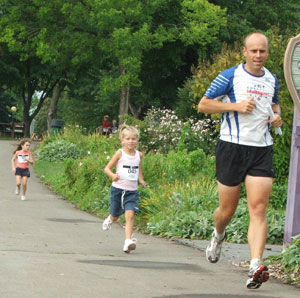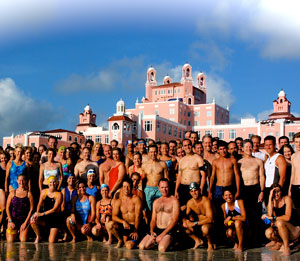Asphalt Green Triathlon Club
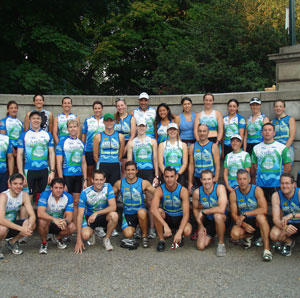
If you want to swim in NYC, people often direct you to Asphalt Green on Manhattan's Upper East Side with a 50 meter indoor and 25 yard outdoor pool on its 5.5 acre sport and fitness campus. The Asphalt Green Triathlon Club is based there and we talked to their president Paul Weiss.
ST: Paul, how old and how large is the Asphalt Green Triathlon Club?
Paul: The club was founded in 2003 with 12 members, and has grown to over 500 members currently. We also have a range of coaching programs, both group and individual, swimming/running instructional programs, and testing services. Our total population of triathletes participating in the club and other Tri programs is over 800.
ST: I believe you are the founder, can you tell us how the club came about?
Paul: I am the founder, and the club was formed almost by accident! I set out to create a "triathlon training institute" built around a yearly seminar series, coaching and instructional programs, and perhaps a small club. The enthusiasm around the club became the driver for all the other triathlon programs, and at no point in the club's genesis did I imagine we would have 500 athletes involved. We were very lucky to attract some fantastic volunteer leaders for the club, and have been fortunate to keep our outstanding coaches for the entire life of the club: Neil Cook and Anthony Carillo, as well as Josh Gold who joined us two years ago. The secret to our success has been very simple: amazing people.
I came to New York from San Jose, California where I was a swimming coach and triathlete. I moved to NYC in 2002 to work at Asphalt Green, a large sports and fitness non-profit with an amazing 5.5 acre campus on Manhattan's Upper East Side, including an indoor 50 meter pool, outdoor 25 yard pool, 2 acre Astroturf field, duplex fitness center, and over 700 sports and fitness programs. I'm the Senior Program Director at Asphalt Green, and all of the program departments report to me (Youth Sports, Fitness, Aquatics, Adult Sports), so AGTC is a relatively small part of a very large sports-focused organization. However, AGTC is quite central to my life in New York.
My most enduring friendships in California were the folks I rode, ran, hiked and swam with, and I simply wanted to meet some people here in NYC who I could play with. I am very proud and pleased that AGTC has become such a successful and central program at Asphalt Green, but I am equally pleased that it has become such a central social network for so many active New Yorkers.
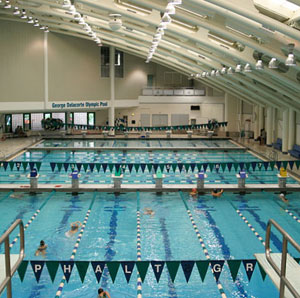
ST: Can you describe these famed New York City swim facilities to our readers?
Paul: AGTC is an Asphalt Green program, and Asphalt Green has the only 50-meter Olympic standard swimming pool in Manhattan. We also have a beautiful outdoor 25-yard pool on our campus. The quote that we love to repeat from New York’s Time Out magazine is "Asphalt Green is heaven if you're a swimmer." We also have a beautiful two-story fitness center with river views, a large spinning studio, lecture halls, massage therapy, and many other programs. I doubt any other Triathlon Club in the country has access to as many resources as AGTC. I sense sometimes that we're a little spoiled. ☺
ST: Which races is AGTC involved with?
Paul: AGTC members did over 70 races last year, and we encourage our members to sign up for and promote any multi-sport event that interests them. Our Web site allows our members to post their personal race schedules, auto-populates a race-roster from these race schedules, and our members can meet each other and plan travel and race-prep/race-day logistics together.
We also try to get as many members as possible involved in "club races." Each club race has a Race Captain who handles pre-race and post-race social activities, organizes cheering sections and race-support, and generally just makes sure everyone that comes to the race feels like they are part of a team.
ST: In addition to racing what are some of the activities offered to club members?
Paul: We have workshops and clinics throughout the year on topics ranging from Race Nutrition to Bike Fit. This year we’re adding Sport Psychology to the workshop list, and re-offering last year’s most popular workshop which was on Physiological Testing and the science behind effort-based training and heart rate zones. We try to offer 8-10 major educational events throughout the year, and several smaller clinics.
We have 9 free workouts per week during the summer, including 2 swims, 3 bikes, 1 Brick, 1 run, strength training, running speed work and drills. This schedule changes seasonally, and right now we’re working out mostly indoors.
Lastly, we have social events! We have happy hours, scavenger hunts, and two BIG parties every year. We just had our holiday party, and we have a black tie awards gala that is a spectacular event every February/March. We also have pre-race and post-race social events for nearly every major race, and we have done training camps in Miami, Austin, and locally.
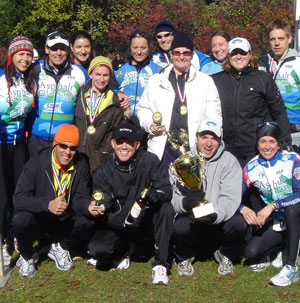
ST: What do you do to encourage new members to join?
Paul: This is a great question!
While we are very proud of our world championship qualifiers, Kona qualifiers, and other speedy AGTC members, we know that the growth edge of the sport, and our club, is the beginner athlete who is new to multi-sport.
To encourage new members to try out the club, and to try out triathlon, we do several things to make it easy to get involved and not feel intimidated:
1) Our Mentor Program: we have over 50 new athletes involved in the mentor program, and about 25 mentors available to guide them. We have an application for both mentors and mentees and we try to match them up based on their preferences (gender, age, race distance, etc.). This has been a great way to get new members up to speed socially as well as involved in workouts and other activities.
2) All of our workouts have multiple leaders and beginner/intermediate/advanced levels. One of the advantages of being a big club is that we get enough people at workouts that we can subdivide them by speed. This allows the more competitive athletes to take an easy day and still do a club workout, and give the beginner athlete a place to start out and train with the group without feeling overmatched or pushed.
3) We have several coaching programs that are geared towards the first-time athlete. These include our "Race-Ready" series that prepares athletes for a specific event over an 8- to 16-week training period in a small group setting, and our "Simply Tri to Lose Weight" program which was developed by two of our AGTC members and is geared towards lifestyle change and weight-loss through a proprietary triathlon curriculum they developed.
ST: Who are some of speakers/guests you had at AGTC?
Paul: We’ve had some great visiting lecturers, including Scott Tinley, Bjorn Andersson, Petr Vabrousek, Mike Plumb, Harvey Newton, and other talented athletes and coaches. Our own coaches and local experts have been terrific workshop presenters as well, including Paul Levine from Signature Cycles, Lee Silverman from JackRabbit Sports, and nutritionist Lauren Antonucci.
We have an extensive staff of sports/fitness experts at Asphalt Green, so a great deal of our educational resources are in-house.
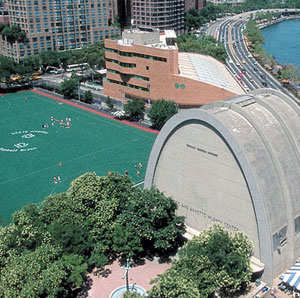
ST: Is there anything that you would say makes AGTC unique?
Paul: Obviously having Asphalt Green as a parent entity provides multiple advantages including the use of the extensive campus for workouts, meetings, and events, but we are certainly more than a facility. We have a dual focus of high performance and inclusiveness, and are uniquely positioned as an organization to provide resources for highly competitive athletes and instruction and guidance for first-timers.
And then, of course, there are our members. We are fortunate to have such a diverse, talented, and passionate group of people, and that’s really what makes AGTC so special.
ST: How old is the oldest and how old is the youngest member?
Paul: We have a youth tri-team that runs in the summer, so our youngest member is 8 years old. I believe our oldest current member is 67 years old, and we’re eager to start scoring some points in the 70+ age group, so we either need to get older or start recruiting!
ST: Anything else we should know about AGTC?
Paul: I think the most interesting thing about AGTC is its context. We operate in a very challenging city for triathlon, and somehow manage to maintain an infectious enthusiasm about the sport. I’m continually impressed by how many New Yorkers are active outdoor sports enthusiasts, and how versatile and creative they are about getting themselves outside. Being part of AGTC highlights the importance of Central Park as a resource, and the incredible value of the New York City Parks Department. Without those resources it would not only be hard to be an endurance athlete in New York City, it wouldn’t be nearly as livable a city. There is something wonderful and energizing about going to Central Park and seeing so many athletes, many in AGTC attire, working out separately, but implicitly together.
The club itself is unique because of how much we offer for free with membership. Very few clubs provide the breadth and depth of club workouts that we provide, and the add-on coaching, testing, and group training services are exceptional and very reasonably priced. Our educational events cover a very broad range of topics, and we offer workshops for the total beginner and the age group elite. There are many great triathlon clubs across the country, so saying we’re the best probably isn’t fair or accurate, but I certainly think we want to be known as a model club, and hopefully USAT recognizes the efforts of our volunteers and staffers to build the sport.



